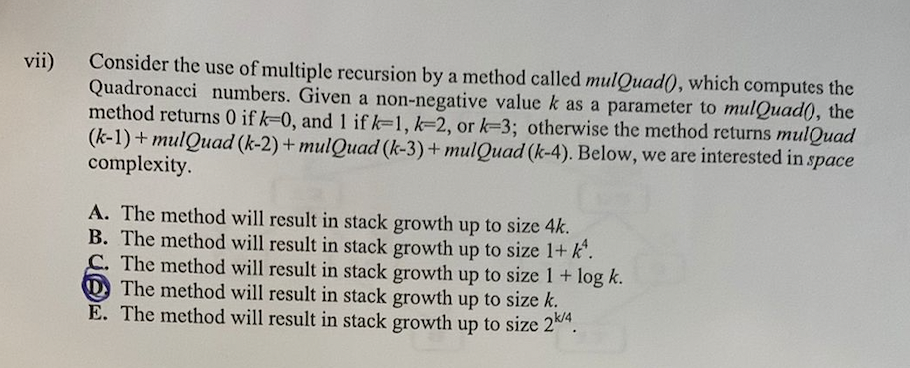Consider the use of multiple recursion by a method called mulQuad(), which computes the Quadronacci numbers. Given a non-negative value k as a parameter to mulQuad(), the method returns 0 if k=0, and 1 if k=1, k-2, or k=3; otherwise the method returns mulQuad (k-1) + mulQuad (k-2) + mulQuad (k-3)+ mulQuad (k-4). Below, we are interested in space complexity. A. The method will result in stack growth up to size 4k. B. The method will result in stack growth up to size 1+ k'. C. The method will result in stack growth up to size 1 + log k. The method will result in stack growth up to size k. E. The method will result in stack growth up to size 2".
Consider the use of multiple recursion by a method called mulQuad(), which computes the Quadronacci numbers. Given a non-negative value k as a parameter to mulQuad(), the method returns 0 if k=0, and 1 if k=1, k-2, or k=3; otherwise the method returns mulQuad (k-1) + mulQuad (k-2) + mulQuad (k-3)+ mulQuad (k-4). Below, we are interested in space complexity. A. The method will result in stack growth up to size 4k. B. The method will result in stack growth up to size 1+ k'. C. The method will result in stack growth up to size 1 + log k. The method will result in stack growth up to size k. E. The method will result in stack growth up to size 2".
Computer Networking: A Top-Down Approach (7th Edition)
7th Edition
ISBN:9780133594140
Author:James Kurose, Keith Ross
Publisher:James Kurose, Keith Ross
Chapter1: Computer Networks And The Internet
Section: Chapter Questions
Problem R1RQ: What is the difference between a host and an end system? List several different types of end...
Related questions
Question
please explain

Transcribed Image Text:Consider the use of multiple recursion by a method called mulQuad(), which computes the
Quadronacci numbers. Given a non-negative value k as a parameter to mulQuad(), the
method returns 0 if k-0, and 1 if k=1, k-2, or k-3; otherwise the method returns mulQuad
(k-1) + mulQuad (k-2) + mulQuad (k-3)+ mulQuad (k-4). Below, we are interested in space
complexity.
vii)
A. The method will result in stack growth up to size 4k.
B. The method will result in stack growth up to size 1+ k".
C. The method will result in stack growth up to size 1 + log k.
D The method will result in stack growth up to size k.
E. The method will result in stack growth up to size 2".
Expert Solution
This question has been solved!
Explore an expertly crafted, step-by-step solution for a thorough understanding of key concepts.
Step by step
Solved in 2 steps

Recommended textbooks for you

Computer Networking: A Top-Down Approach (7th Edi…
Computer Engineering
ISBN:
9780133594140
Author:
James Kurose, Keith Ross
Publisher:
PEARSON

Computer Organization and Design MIPS Edition, Fi…
Computer Engineering
ISBN:
9780124077263
Author:
David A. Patterson, John L. Hennessy
Publisher:
Elsevier Science

Network+ Guide to Networks (MindTap Course List)
Computer Engineering
ISBN:
9781337569330
Author:
Jill West, Tamara Dean, Jean Andrews
Publisher:
Cengage Learning

Computer Networking: A Top-Down Approach (7th Edi…
Computer Engineering
ISBN:
9780133594140
Author:
James Kurose, Keith Ross
Publisher:
PEARSON

Computer Organization and Design MIPS Edition, Fi…
Computer Engineering
ISBN:
9780124077263
Author:
David A. Patterson, John L. Hennessy
Publisher:
Elsevier Science

Network+ Guide to Networks (MindTap Course List)
Computer Engineering
ISBN:
9781337569330
Author:
Jill West, Tamara Dean, Jean Andrews
Publisher:
Cengage Learning

Concepts of Database Management
Computer Engineering
ISBN:
9781337093422
Author:
Joy L. Starks, Philip J. Pratt, Mary Z. Last
Publisher:
Cengage Learning

Prelude to Programming
Computer Engineering
ISBN:
9780133750423
Author:
VENIT, Stewart
Publisher:
Pearson Education

Sc Business Data Communications and Networking, T…
Computer Engineering
ISBN:
9781119368830
Author:
FITZGERALD
Publisher:
WILEY